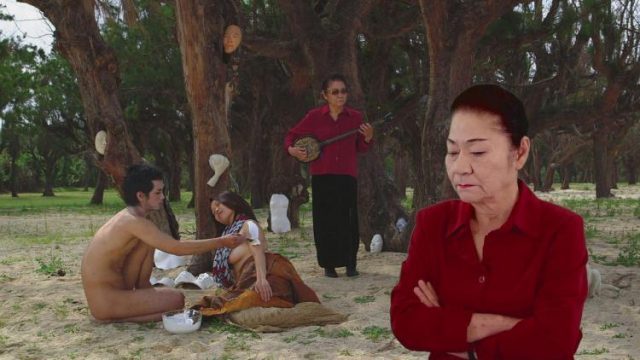
Go Takamine is back with his first film in nearly twenty years, the surreal and magical Hengyoro
FESTIVAL OF NEW JAPANESE FILM: HENGYORO (QUEER FISH LANE) (変魚路) (Go Takamine, 2017)
Japan Society
333 East 47th St. at First Ave.
Saturday, July 15, 2:30
Festival runs July 13-23
212-715-1258
www.japansociety.org
 “Has my head been emptied? No matter how I cut this film, the blood of Okinawa spews forth,” iconoclastic Japanese auteur Go Takamine says about Hengyoro, his first film since 1989’s Untamagiru. The Okinawan-born writer and director has been making shorts, features, and documentaries about his home island since 1974, including Okinawan Dream Show, Okinawan Chirudai, and 1985’s extraordinary Paradise View. Hengyoro, which is having its international premiere July 15 as part of Japan Society’s annual Japan Cuts Festival of New Japanese Cinema, is set in Patai Village (Ifepataijyo) on Okinawa, where despondent souls who have survived death reside. Aging actors Tarugani (Taira Susumu) and Papajo (Kitamura Saburou) are putting on the “chain plays” Tomaiaka and Kurukanizashi, which combine film and theater. Meanwhile, Kame is making a plaster cast of a partially nude woman, hard rocker Missiler dances madly, serenading folksinger Ryukyu Lewd Bug leads a pack of unusual animals, and shop owner Shimabukuro Seitoku sends his trio of ear-cutting wives, the Bibiju, after Tarugani and Papajo. There is also an underwater plastic surgery lab, dragonfly spy planes, illegal aphrodisiacs, cranial ant insertion, a magical red cord and matching bag, and explosions that go “Pshoo.”
“Has my head been emptied? No matter how I cut this film, the blood of Okinawa spews forth,” iconoclastic Japanese auteur Go Takamine says about Hengyoro, his first film since 1989’s Untamagiru. The Okinawan-born writer and director has been making shorts, features, and documentaries about his home island since 1974, including Okinawan Dream Show, Okinawan Chirudai, and 1985’s extraordinary Paradise View. Hengyoro, which is having its international premiere July 15 as part of Japan Society’s annual Japan Cuts Festival of New Japanese Cinema, is set in Patai Village (Ifepataijyo) on Okinawa, where despondent souls who have survived death reside. Aging actors Tarugani (Taira Susumu) and Papajo (Kitamura Saburou) are putting on the “chain plays” Tomaiaka and Kurukanizashi, which combine film and theater. Meanwhile, Kame is making a plaster cast of a partially nude woman, hard rocker Missiler dances madly, serenading folksinger Ryukyu Lewd Bug leads a pack of unusual animals, and shop owner Shimabukuro Seitoku sends his trio of ear-cutting wives, the Bibiju, after Tarugani and Papajo. There is also an underwater plastic surgery lab, dragonfly spy planes, illegal aphrodisiacs, cranial ant insertion, a magical red cord and matching bag, and explosions that go “Pshoo.”
Along the way, Go references Bruce Conner, Bill Morrison, Ingmar Bergman, and Alejandro Jodorowsky, so don’t expect to make much sense of the story. Gorgeously photographed by Takagi Shunichi and Hirata Mamoru, showing off the landscape as well as Sakata Kiyoko’s dazzling costumes, the film roams from black-and-white to color, from regular speed to slow motion, incorporating multiple genres and narrators amid changing film stocks as Go and editor Shun’ichi Takagi imaginatively mix in decomposing celluloid and archival footage Go shot years ago; he also populates the film with superimposed miniature people on brain coral and ghostly faces in trees, all set to a wildly diverse soundtrack by Nobuyuki Kikuchi. So what’s it all about? Is it a surreal commentary on WWII and the dropping of the atomic bombs? A sly take on the discrimination Okinawans have encountered from Japan? An exploration of storytelling itself? Does it even matter? Hengyoro, whose English title is Queer Fish Lane, is a visual and aural treat, an artistic feast that is as strange and confounding as it is entertaining and endearing. “We’ll follow wherever our path leads,” Papajo tells Tarugani; we’ll follow wherever Go’s path takes us. Hengyoro is screening July 15 at 2:30 in the Experimental Spotlight section of Japan Cuts; the festival runs July 13-23 with such other works as Yuki Tanada’s My Dad and Mr. Ito, Kiyoshi Kurosawa’s Daguerrotype, Sion Sono’s Anti-Porno, and the North American premiere of the restoration of Seijun Suzuki’s 1980 Zigeunerweisen.